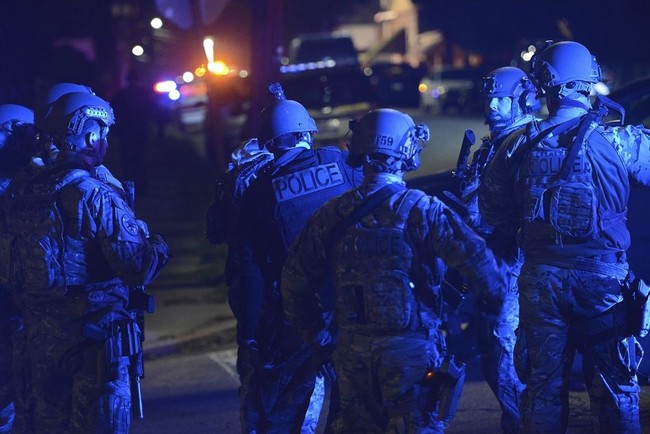
The Prank That Became a Weapon
It used to be a term known only in gamer forums and YouTube livestreams: “swatting.” What began as a dark joke in the digital underground has metastasized into a full-blown public threat.
This isn’t about annoying prank calls or fire alarms being pulled at high school assemblies.
Swatting is armed psychological warfare, weaponizing our emergency response systems, and manipulating public trust.
This week, Romanian national Thomasz Szabo pleaded guilty to organizing over 75 swatting attacks against public officials, including a former U.S. president.
This wasn’t a misguided teenager calling 911 on his Xbox rival.
This was a calculated, premeditated cyber assault that involved impersonating victims, spoofing caller IDs, and deploying American SWAT teams like pawns.
And he’s not the only one.
The swatting epidemic has hit public officials, celebrities, school districts, election workers, and private citizens. Targets have included Congressional personnel, judges, state capitol buildings, and ordinary families whose only mistake was getting noticed by the wrong person online.
This is no longer a fringe issue.
It is a domestic vulnerability being ruthlessly exploited.
What Is Swatting and Why Is It So Dangerous?
Swatting involves making a fake emergency call to law enforcement, usually claiming there’s a violent situation, hostage-taking, murder, or an active shooter situation unfolding at a specific address.
The goal is to trigger a heavily armed police response, often in the form of a SWAT team, to that unsuspecting location.
Think about the stakes: An innocent person answers the door, often groggy or confused, to dozens of armed officers ready to breach. One wrong move, one misunderstood gesture, one twitch of the wrong muscle, and that person could die.
This isn’t paranoia. It’s already happened.
In 2017, 28-year-old Andrew Finch was shot and killed by Wichita police responding to a bogus call.
He had no connection to the gamer feud that sparked the incident.
He wasn’t the intended target.
He was just home.
In 2020, 60-year-old Mark Herring of Tennessee died of a heart attack after police swarmed his home following a fake call. His offense? Refusing to give up his rare Twitter handle, “@Tennessee.”
The perpetrators often use tools such as VoIP services, caller ID spoofing, and VPNs to conceal their locations, making prosecution challenging.
They can operate from across the globe yet reach into the homes of American citizens in seconds, with nothing but a keyboard and a sick mind.
When It All Changed
There was a time when swatting was mainly confined to the world of online streamers and gamers, who would provoke attacks for clout or revenge.
But like many cancers, it evolved and spread.
Between 2022 and 2024, swatters began targeting judges, congressional offices, school boards, and even synagogues. In one week alone, at least 12 U.S. public officials, including Rep. Marjorie Taylor Greene, were swatted.
In one particularly vile instance, the home of Rep. Brandon Williams (R-N.Y.) was stormed while his children were asleep.
These are not kids playing games anymore.
These are ideologues, trolls, extortionists, and foreign actors.
And they’re getting bolder.
According to the FBI’s national database, there have been over 550 documented swatting incidents involving public officials, judges, and election workers since 2023. And those are just the ones we know about.
Many states and municipalities lack standardized reporting protocols for swatting, meaning the actual number is likely much higher.
In Florida, over 1,500 swatting calls were reported in 2023 alone, with many targeting schools.
The cost? Over $65 million in law enforcement response and lost instructional time.
The Hidden Costs: Dollars, Dispatches, and Distrust
Swatting doesn’t just endanger lives; it bleeds public resources dry.
Every legitimate SWAT deployment costs between $10,000 and $25,000, depending on the jurisdiction.
Multiply that by hundreds of false calls, and you see how destructive this is to law enforcement budgets, time, and readiness.
Worse, every fake call draws officers away from genuine emergencies, heart attacks, break-ins, and domestic violence.
While a SWAT team is responding to a hoax, someone else may die across town waiting for a unit that’s not coming.
And then there’s the emotional toll, both on victims and responders. Officers are trained to go into these situations expecting life-or-death danger.
When it turns out to be a hoax, the psychological whiplash and potential for overreacting the next time are immense.
Think of parents rushing to schools in tears because of a fake shooting report.
Think of elderly homeowners screaming at armed officers, who don’t understand.
The long-term trauma cannot be overstated.
Fighting Back: What the Law Is (and Isn’t) Doing
To be blunt, law enforcement has been playing catch-up.
The technology criminals use has outpaced the rules meant to stop them.
The federal government has recently taken this seriously. In early 2025, Senator Rick Scott introduced the Preserving Safe Communities by Ending Swatting Act, which would impose federal prison time of up to 20 years if someone is seriously injured and life imprisonment if someone dies.
It’s a step forward, but Congress still hasn’t passed comprehensive federal protections for victims or standardized data collection.
At the state level, efforts vary. Michigan’s Senate Bills 202 and 203 would make swatting a felony, with escalating penalties based on harm caused.
California, Washington, and Texas have passed laws making swatting punishable by up to five years in prison, even if no one is hurt.
Some cities, such as Seattle, now offer voluntary registries for individuals who fear they may be at risk of being targeted.
When a suspicious call comes in, dispatchers cross-reference the registry and approach the scene with caution.
It’s smart. It should be a national policy.
But we need more.
The Cultural Rot Behind the Keyboard
Let’s call this what it is: evil.
Not mischievous.
Not misguided.
Evil.
These aren’t harmless trolls.
These are cowards, often anonymous, sometimes overseas, who hide behind technology to play god with other people’s lives.
They don’t care who gets hurt.
In fact, they hope someone does.
They use swatting to settle petty scores, silence political speech, terrorize religious minorities, and manipulate democratic institutions.
And every time they get away with it, they embolden the next one.
Protecting the Front Door
If there is one place Americans deserve to feel safe, it is their home.
But in the age of swatting, even the sanctity of your front door can be shattered by a stranger with a grudge and a voice-changer app.
This is not a partisan issue.
Whether the target is a Republican lawmaker or a liberal schoolteacher, swatting is an assault on our civic trust and personal liberty.
We need mandatory sentencing guidelines.
We need cross-state registries.
We need more effective 911 verification tools that can identify spoofed calls in real-time.
And we need the political will to treat this as what it is: a growing form of domestic cyberterrorism.
No one should live in fear of answering their door at night.
No child should huddle in a classroom because someone wanted a few likes on Discord.
No SWAT officer should be forced into an ambush of confusion because someone 3,000 miles away pressed “Send.”
Mask mandates are reappearing in liberal enclaves. Apparently, they think 2020 nostalgia is in.
We never forgot. Join PJ Media VIP with promo code FIGHT to save 60%.








